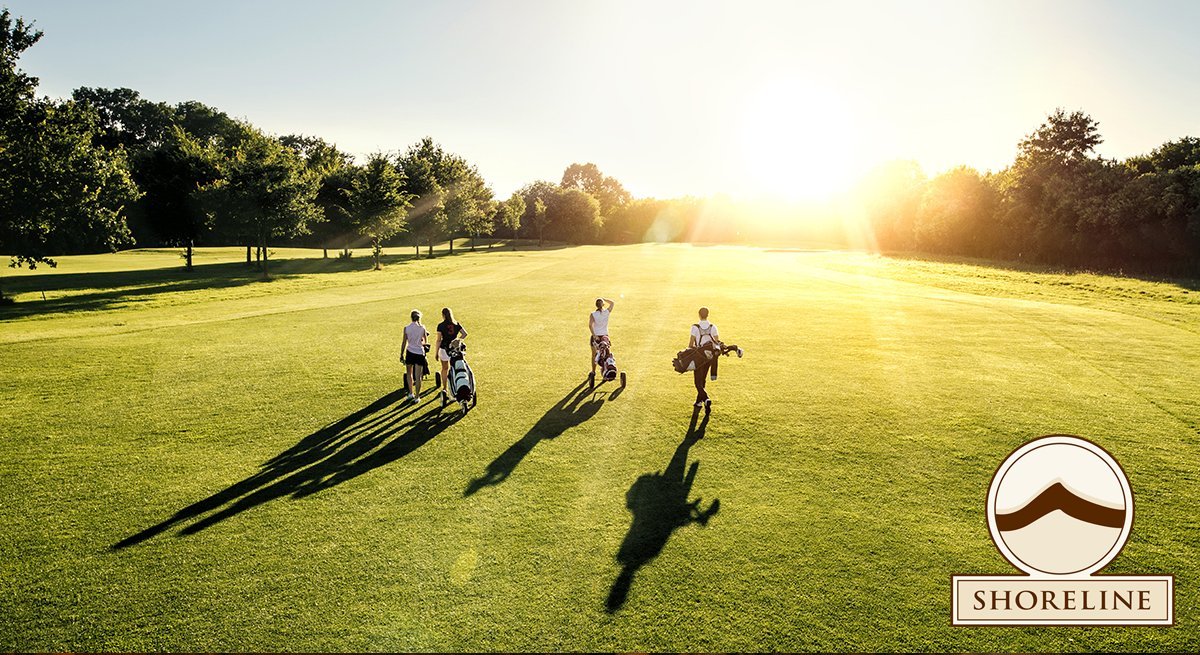There’s a myth among golfers that topdressing ruins playability. When a golf course sprays course sand over its putting green, which can usually be seen as a shimmery top layer that reflects pale light in direct sun, it does indeed reduce the firmness of the playing surface for a while. This effect is temporary, however, and a golf course that uses regular topdressing will almost always have a superior putting surface that golfers may come to take for granted, if they ever think about it at all.
What is Topdressing?
Topdressing is the act of spraying sand over a grass surface, usually the putting green at a golf course, in order to improve its playing characteristics. Sand from a hopper is sprayed out from the back of a groundskeeping vehicle to evenly cover the putting area, usually as a single layer at a time. Together with all the other things a golf course has to do for its lawns, such as irrigation, fertilizer application, weed control and so forth, topdressing helps to turn what would otherwise be a bumpy, uneven patch of spotty grass into the best playing surface possible for golf.
What are the Benefits of Topdressing for Golf Courses?
Golf courses choose to topdress their greens for a lot of reasons. Putting down a layer of fine sand does a lot for the grass, and routine reapplication cultivates the greenery into just what a golf course needs. Benefits of topdressing include:
- Smoothing out rough ground. The layer of sand being dropped on the grounds is a good mechanical filler that finds its way into every tiny void in the soil. Rough soil always has gaps in it, and there are little caverns and voids left by the expanding root structures and other underground irregularities in the surface of the soil. Under the top layer of mature grass, you’ll probably never see these voids and jagged terrain features, but you’ll definitely notice if your ball keeps veering off in odd directions or taking bad hops on what looks like a smooth putting green. Of course it takes a little while for this sand to work its way all the way down into every void, so immediately after a topdressing you might notice little dips and bumps in the turf. This is a major part of the reason for topdressing’s bad reputation among many golfers, but it does go away after a couple of days.
- Diluting thatch. Immediately under the top of the grass, in the upper root zone, there’s usually a lot of old, semi-decomposed organic material rotting away. This is extraordinarily good for fertilizing the turfgrass, but it makes a bumpy surface inevitable. Thatch is the bits of this terrain where organic mulch has concentrated and formed little hummocks that act as speed bumps for a golf ball, or worse, as a spongy area that has a really inconsistent texture. Topdressing areas of thatch firm up the soil in these spots, and by smoothing out the hummocks it makes the mower far less likely to scalp the turf when the blades go over a rough area.
- Firming up the turf. All that thatch soaks up water and gets squishy. Put your foot down on one of these spots, and you might even see water gush out of a tear in the turf, especially after heavy watering or a recent bout of rain. Soft and unpredictable soil is awful for putting true, and topdressing helps prevent this problem. When the soil around thatch is properly dressed, the sand acts like a tiny retaining wall that holds up the sides of what would otherwise be soft, weak thatch. Better still, the loose grain structure of the sand lets excess water drain out, so the soil stays close to the conditions a golf course wants. Even better than that, as the thatch drains and shrinks a bit, the loose sand around it slides inward to maintain a firm surface, even if the thatch totally dehydrates and dips into a shallow bowl.
- Recovery and protection of new shoots. Grass grows, lives and dies fast, and there are new shoots coming up all the time. This gets hectic during the busy summer growing season, which coincidentally happens to be the most popular time for golfers to arrive and roll damaging hard balls across the surface of the green. The sand laid down in a good topdressing forms a protective cushion around new shoots, shielding them from top-down damage during their delicate first few days above the soil. So when you walk or roll a ball over the rapidly growing turfgrass, you won’t hurt next week’s crop as it grows surrounded by protective sand.
- Building a healthy substrate. The structure of turfgrass reaches several inches under the visible surface of the soil. In this root zone, which is mostly a tangle of grass roots, worm tunnels, various bits of fungus and organic composites, the texture is a lot like a sponge. That sponge holds a lot of water, and it can drain off in some odd ways. Worse, too much water under the surface can drown the roots of grass that isn’t adapted to overly wet climates. So you could have a situation where either the top of the turf is getting the right amount of water but the roots are sodden, or the roots are okay but the top grass is dry as a bone. Topdressing solves this too by layering loose-pack sand into the deepening layers of soil. Improved drainage and aeration prevent pooling water, drowning root structures and the fermentation of anaerobic bacteria, which turns everything into slime eventually.
What Happens if a Golf Course Doesn’t Topdress its Terrain?
Topdressing a golf course clearly comes with a lot of benefits, but it’s still annoying to play right after it’s been done. So what happens if a golf course decides to skip it for a while? What are the consequences if your local golf course just stops, or if it spaces out its usual aeration program?
Immediate Effects
At first, you might appreciate a lack of topdressing. In the first few days after skipping a treatment, the grass feels pretty firm and lush, and there’s no unpleasant sandy interference with how your shots roll. You might actually like it a lot more than the usual experience, and that irritating sheen the putting green has won’t be there. This doesn’t last, though.
One Week
After a week without topdressing, the new shoots coming up will be showing signs of their rough upbringing. Without the protection and support of fine sand early on, these new shoots are more likely to be frayed and bent in odd directions. The surface of the green will appear duller, and you might notice a softer top that drags on how a ball rolls. You’ll have more friction, and the close-in shots you’re taking will have an annoying habit of stopping just short of the hole.
Two Weeks
After another week, the voids filled in with sand will have started opening up again. As the last sand treatment subsides, which is unavoidable because of gravity and the settling effects of irrigation, those dips and culverts will make the terrain under the turfgrass bumpy again. Worse, you probably won’t be able to see the increasing irregularity under all that grass, so where your ball is going to go is anybody’s guess. This is a problem that only gets worse over time.
One Month
Water has now begun to pool underground, as the drainage the sand provided wears away. Root structures are easily damaged by too much water, and the lack of underground flow has created dry spots where roots can’t get enough water with normal irrigation. In some places the turf looks dark green from overwatering, while in others it’s yellowing because it’s too dry. Those dry patches will eventually be replaced by more aridity-resistant species like crabgrass, which is not fun to play on.
Three months
The dips and voids will now be pronounced. Normal mowing is taking chunks out of the turf, as little thatch hummocks are becoming more prominent. Between these little hills, dips in the terrain aren’t getting mowed deeply enough and the grass is unusually long. Your ball will roll faster over the bare spots and crash to a stop in the dense thickets in the dips. Soil may be settling in the root zone, causing larger depressions. Sections of the turf can come loose and create a kind of bubble under the root network where the grass isn’t firmly anchored. By this stage, you’re likely to see persistent footprints, tire tracks and deep ball marks all over the green, since the soil can’t bounce back from impacts the way it used to.
Six Months to One Year
When the greens have gone this long without topdressing, they’re nearly unplayable by modern standards, and serious rehab will be needed if they’re ever going to get back in shape. Soil underlayment has probably separated into discrete layers of sand and organic soil, creating a heterogeneous structure that’s unpleasant to walk on and unpredictable to play over. Oxygen can hardly move in this soil, so an organic sludge will start to form under what remains of the turf, like a compost heap that never gets turned over. Root development is badly hampered, and it wouldn’t be surprising to see a large die-back of the delicate turf, followed by lots of dandelions.
How is Topdressing Done?
Given its importance, it’s good that topdressing isn’t really that hard to do. There’s definitely a right way to do it though, and depending on which type of grass is growing on the green, a golf course will usually follow an eight-step process:
- Break up thatch: Using a power rake or industrial aerator, the grounds crew will break up patches of rough grass and thatch. This opens up channels for the sand to flow down into the root structure, and also acts as a nice preliminary aeration for the greenery.
- Clean up the lawn: Thatch removal and aeration make a mess, so the torn-up thatch and loose clippings need to go. On a professionally maintained golf course, this is usually done with riding equipment, though you could do it on a smaller scale with a rake.
- Cut it short: The crew runs the mower over the turf, starting at a high blade setting and then dropping to the minimum the grass can stand. Topdressing works best on short grass, since there’s less material in the way and the sand can settle more evenly.
- Lay down extra seed: Now’s a good time to overseed, so the team might toss down a layer of fresh grass seed to plug any gaps and take advantage of the better germinating conditions the turf will have for the next few days.
- Drop the sand: A commercial vehicle rides over the turf and sprays the sand pretty much evenly over the whole surface being treated. A second pass can be done, but it’s usually not necessary.
- Rake again, then water: Immediate agitation and irrigation helps the sand settle in, and it should be done as soon as possible after dressing.
- Put out caution tape: It’s important to avoid foot or vehicle traffic for a few days to one week after a first topdressing. This rule can be bent a little for a golf course, but the first few days are critical for getting a good settling of the sand.
- Watch the grass grow: The last step in good topdressing takes weeks. The grounds staff at a golf course will check to see how the turf is doing at intervals during the growing season and reapply as necessary.
What Kind of Sand is Used for Topdressing?
The type of sand used for topdressing matters, largely for its grain size and physical properties. Most places use masonry sand or play sand, since these have the right grain size and are generally chemically inert. They’re also affordable and can be bought in bulk, which is good since it takes about 0.77 cubic yards to cover 1,000 square feet to a depth of just a quarter of an inch.


